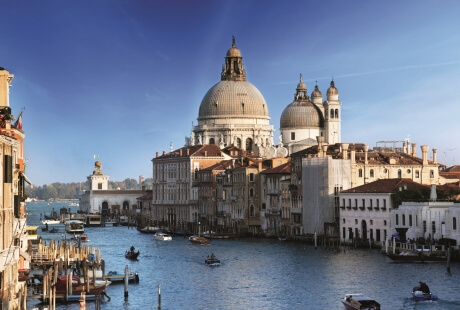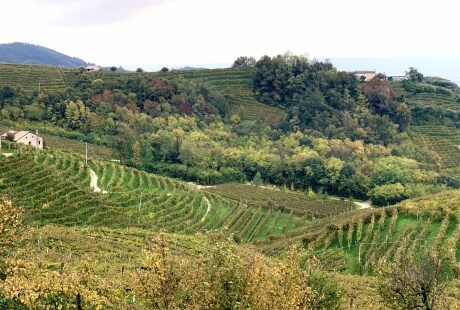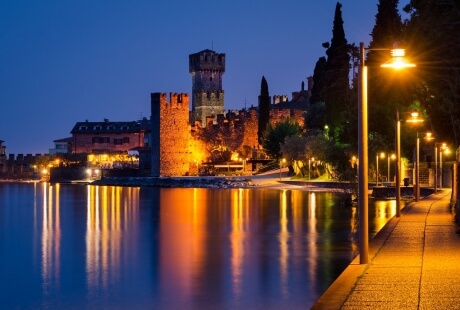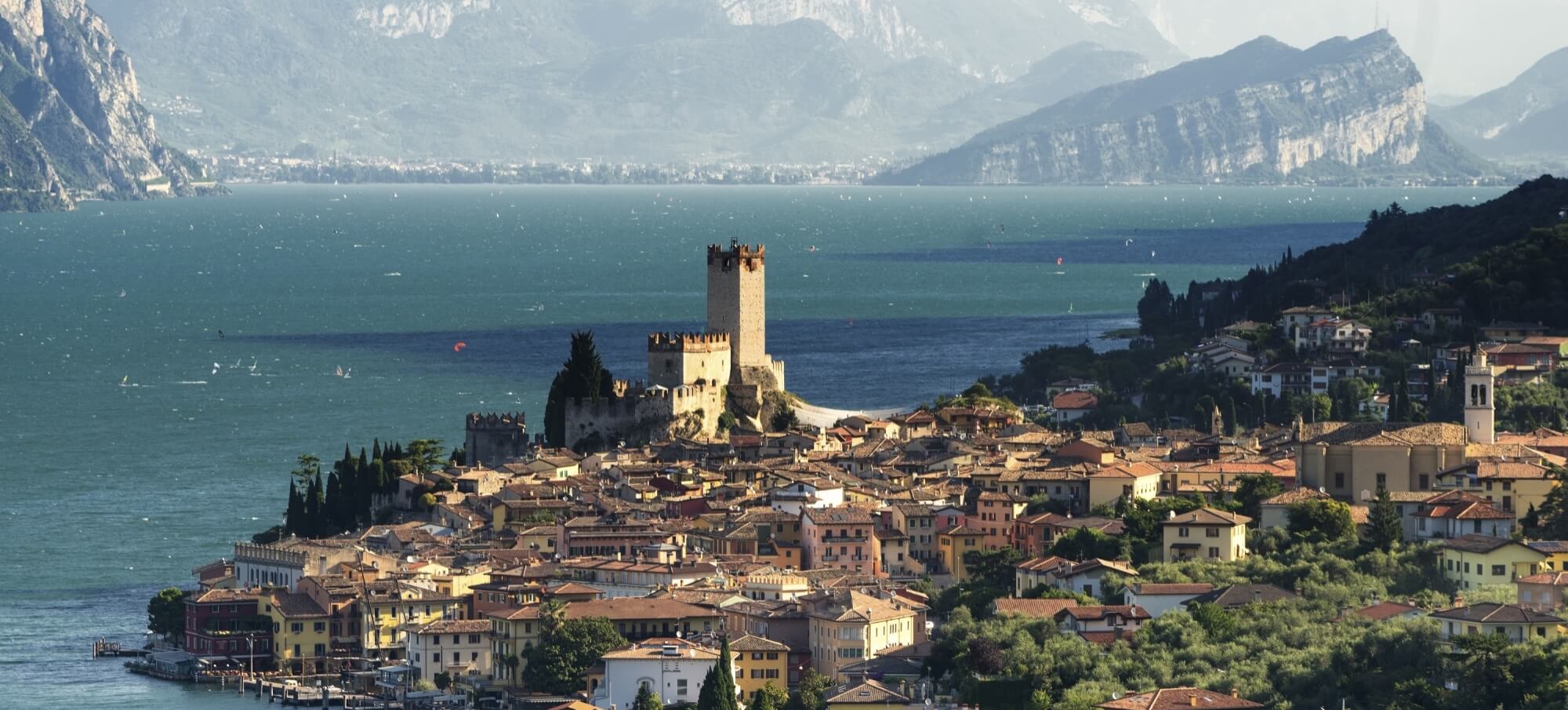5 travel ideas around the Dolomites and Lake Garda
Wonders of Veneto and beyond: 5 travel ideas around the Dolomites and Lake Garda
As travellers around the world are raring to go back to a joyful habit entailing tours, discoveries, experiences and new adventures, they will have certainly drawn up a list of places they want to go and see. Pretty much like a celebration – something old, something new, something borrowed… - famous tourist hotspots, together with recently discovered hidden gems, will top the travel trends for 2021. When it comes to renowned and much-loved destinations, Italy certainly ranks high in everyone’s imagination, and yet you may easily come across a previously unknown area, territory or place – to the joy of many visitors, including Italians. From north to south and across all the regions, the peninsula is rich in historical and artistic treasures, dramatic landscapes and such delicious food that stealing their recipes may just about recreate its goodness. Have we mentioned the unmistakable sense of welcoming and legendary hospitality? Let’s embark on a journey where “old friends” meet new discoveries, exploring the north-west region of Veneto, from the biggest Italian lake – Lake Garda – to unforgettable Venice, packing in romantic cities, imposing mountain peaks and a very exciting wine route.

1. Fascinating reflections on the water: welcome to Venice
Will the lure of Venice ever fade? We strongly doubt it, which is why a trip to this legendary marvel on the lagoon is always good news. The floating city is best approached by water, taking in all the grandeur of such an unthinkable masterpiece, lavish palaces magically resting on water in a series of original geometries, perspectives and vanishing points. Once there, you can get lost along the many calle, going up and down the more than 400 bridges in the six sestieri making up the historic centre, walk into a church to discover a 17th century altarpiece, stand in St. Mark’s square and gaze in awe at the vast piazza, then admire the shiny mosaics in the Basilica, with evocative Palazzo Ducale crowning the scene. Everything you do in Venice seems to come with its fair share of dreamlike aura, and there is always a new corner to peruse, a fascinating palazzo to marvel at or an artisan shop you can find funky artworks in. Head to the Isola di San Giorgio Maggiore for a close encounter with several works by Jacopo Tintoretto and other Venetian artists – in the sublime Benedictine abbey of San Giorgio Maggiore, designed by Andrea Palladio - then go up its belltower for exquisite views of the city.
Visit the Fondazione Giorgio Cini, a temple of beauty with a cloister by Palladio, a labyrinth with 3200 boxtrees, and a pleasant wood decorated with art installations. You could also explore the magnificent Peggy Guggenheim Collection in Dorsoduro: the incredible legacy of a pioneering American collector, this is a temple of modern art with works by Picasso, Magritte, Kandinsky, Severini and Balla, among the many on display. Book lovers will revel at the Libreria Acqua Alta in the Castello quarter, an offbeat bookstore with several vintage titles gathered in a fabulous display; you may even approach it directly by boat. Venice is cinematic beauty, a ”splendour of miscellaneous spirits”, in Ruskin’s words, and a treasure to be savoured with gentle delight.

2. Sas dla Crusc, the symbol of Val Badia Dolomites
“Travelling is a state of mind”, as the saying goes, and discerning travellers will want to explore exclusive places that reveal the essence of the area they are visiting. If we are talking about the Dolomites, mighty custodians of a natural, majestic landscape, you will need to establish a personal relationship with rock to really comprehend their heart. From the Conturines to Lagazuoi, it’s a magical game where every peak, every rock face and every panorama has a story to tell. Still, there is one that seems to have captured people’s imagination more than other ones: imposing and magical Sas dla Crusc.
“No other mountain in the Dolomites possesses its colours and its shapes”, in the words of the austrian alpinist Heinz Mariacher: this superb mountain in the Fanes- Senes-Braies Natural Park and part of the Fanes group has its the highest peak – Sas dles Diesc – reaching 3.026m and a superbly panoramic one, the L’Ciaval, overlooking the entire Alta Badia. The place comes with its own legend, according to which local hero Gran Bracun fought a dragon that was living in the mountain, saving the population; most probably any alpinist who has tried to send a route on its walls was probably equally scared. Attracting the crème de la crème of mountaineering history, from Le Grec Georges Livanos to the Messner brothers, Christoph Hainz to Nicola Tondini, this mighty mountain is still the testing ground for top alpinists and several pages of modern mountainerring history were written here. Embracing the cultural background that animates the Dolomites, every trip to the area is a new discovery, a close encounter with the soul of these sensational stone cathedrals. Of course you do not need to be a seasoned mountaineer to enjoy it all: make the most of the excellent local trails – by bike or on foot – take in the superb views and embrace the refined local cuisine: South Tyrol embodies excellence through and through.

3. A territory inside a bottle: Prosecco
The quintessential aperitivo choice for most Italians and around the world, Prosecco is a sublime drink that lives as an expression of the territory it stems from. The Prosecco hills, part of the UNESCO World Heritage Site, are nestled between the Prealps and the Piave river, to the northwest of the Veneto region; the area is so rich in dramatic landscapes and sublime vineyards that it has attracted writers and poets across the centuries. The Strada del Prosecco (Prosecco Wine Road) is the oldest of its kind in Italy – it was established in 1966 – and connects the towns where this delicious wine is produced: Valdobbiadene, Conegliano and Vittorio Veneto are only a few of the pretty towns along the road. Art lovers may also know Conegliano because of local Renaissance artist Cima da Conegliano and his works depicting scenes from the life of Christ, Madonna and Child or various saints; it is, however, certainly Bacchus enthusiasts who love to explore the area as this is, in fact, where Prosecco Conegliano Valdobbiadene DOCG originates. Cartizze, closer to Valdobbiadene, is perhaps the most prized area producing Prosecco: the precious Prosecco Superiore di Cartizze grows on a mere 106 hectares and each one of them is listed on the Stock Exchange for a value exceeding one million euros. (!) Bear that in mind next time you savour this heavenly delicacy, which boasts more complexity and a greater depth of flavour.
Prosecco is culture and passion and this sparkling wine can only be produced in select parts of north-eastern Italy; generally made by refermenting the wine in steel tanks, a technique known as Charmat Method, Prosecco also comes in a semi-sparkling and a still version and it features several levels of sweetness, from Brut, Extra-Dry, Dry to Semi-sec.
Touring the area is, however, not only a feast for Bacchus lovers as you will also find several exquisite landmarks: the pretty square in Serravalle by Vittorio Veneto, the 17th century Camaldolese hermitage in Rua di San Pietro di Feletto, and old mill, as the one in Refrontolo, known as the Molinetto della Croda, and luxurious villas: Villa Brandolini d’Adda in Solighetto, close to Pieve di Soligo, is home to the Prosecco Consortium. In Conegliano you will also find the Cerletti Wine School: the oldest one in Italy, it was established in 1876 and some of the most renowned wine experts learnt the tools of the trade here. Let’s join in the fun and raise a glass!

4. Verona, sweet Verona
People come to Verona in search of love, to admire a perfectly conserved Roman amphitheatre and to wander the many lovely streets – in addition to enjoying the excellent Veneto cuisine and wine. William Shakespeare may well have made this city eternal, and yet you can find so much more than Juliet’s Balcony, for Verona is brimming with life, excitement, superb artworks in equally splendid churches and marvellous bridges. It is also, of course, a short drive from stunning Lake Garda, which makes a trip to the Della Scala city an exceptional day out, if you are based on the shores of Italy’s largest lake. When your appetite for all things Bard-related is met, you can start exploring the real soul of Verona.
Art enthusiasts will love the Museo di Castelvecchio: partially destroyed by Napoleon and during WWII, a cutting-edge restoration plan gave it new lymph: it now boasts an enviable collection of masterpieces (Rubens, Tintoretto and Bellini among them) and it hosts important exhibitions, in addition to being a superb castle in its own right. If it’s churches you are after, you will be spoilt for choice: take in the lovely fresco by Pisanello depicting Saint George and the Princess in Saint Anastasia, a glorious Assumption by Titian in the Duomo, Mantegna’s famous altarpiece and the Bronze doors in San Zeno, or the lower and upper Churches of San Fermo – and this is just the centro storico. Or why not escape to lush Giardino Giusti, further up the hill and across the river: considered a jewel of Renaissance landscaping, it was established in the 15th century by the Giusti family and is adorned by plants, grottoes and fountains: some of the best views of the city are to be had from here. You could then stroll along Verona’s bridges, Ponte Pietra being one of the prettiest: sit at a café to admire it in its full glory. And don’t forget the lovely piazzas: Piazza dei Signori and Piazza delle Erbe are simply delightful and that’s where the buzz magically appears, with people sitting in cafes, happily chatting away. Fair Verona, we simply love you.

5. Music and wine on lake Garda
Italy’s largest lake, Lake Garda, really needs no introduction. Where else can you find ruins of a Roman villa on the lake – Grotte di Catullo, Sirmione – ethereal castles aplenty – Sirmione, Malcesine, Desenzano sul Garda and many more – a fjord-like northern part of the lake with sheer faces cascading into the water, epic winds that offer adrenaline-rich sailing, delicious, locally produced olive oil that tastes divine and wine routes to nurture the soul? The enduring beauty of the Italian lakes makes Italy’s northern regions a year-round, striking destination; spanning across three Italian regions, Lake Garda has always been a favourite tourist spot, ever since Roman times. A mild climate, an exceptional variety of scenery, along with art, culture and splendour means that you can enjoy a wealth of fabulous landmarks: the Vittoriale degli Italiani in Gardone Riviera, the eccentric former home of poet and soldier Gabriele D’Annunzio, is a triumph of architectural excess. The Amphitheatre, part of the complex, hosts much-admired musicians during a critically acclaimed summer festival, taking place in a superb setting.
Wine clearly features predominantly around the lake, some of the most exquisite labels being produced here; an innovative way to explore the area may be with a bike tour. Starting south of Gardone, you could cycle around Mount San Bartolomeo by Salò, to explore innovative vineyards, between Manerba and San Felice to see the sweet-looking olive trees surrounding the Rocca di Manerba, or further inland south-west of the lake, to see the Valtenesi region, where superb wine is produced. Move between Bedizzole and Calvagese to enjoy delightful tranquillity and absolute calm. There exist several wine routes across and around the lake, taking in Soave, Valpolicella, Bardolino, and Franciacorta, among the many varieties, so getting thirsty is not an option here. You may also see the magnificent gardens in full bloom: the Andrè Heller Garden in Gardone Riviera is replete with several plant species that mingle perfectly with statues and various ornaments. Monte Baldo offers a sublime Botanical Garden and an observatory; the Parco Giardino Sigurtà, close to Verona, features richly coloured flowers, a labyrinth, a sundial, officinal plants, a giant oak tree and an educational farm for a superb day out.
Travel Tips where to stay:
Lake Garda:
- Grand Hotel Fasano Gardone
Dolomites:
- Ciasa Salares San Cassiano Alta Badia
- Gardena Grödnerhof Ortisei Val Gardena
Ask for more info about the best experiences and itinereraries we can design in the Dolomites, Lake Garda and beyond
All contents, photos and texts are subject to copyright. They are only authorised on my website and social media. Ideas can be a source of inspiration, but any unauthorised use of images and texts is strictly forbidden. All rights reserved.

